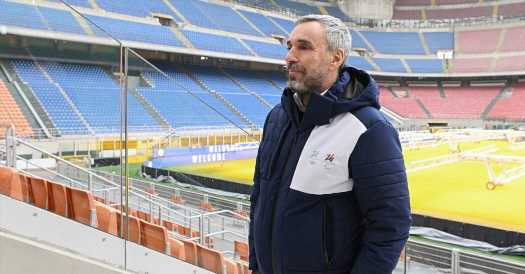The floor-to-ceiling windows in Andrea Varnier’s 44th-floor office offer a sweeping view of Milan and some of the mountains that will host the 2026 Winter Olympics, but Varnier jokes that the panorama is not for him. He is almost never in this office, he admits. He rarely uses the desk. There is just no time to sit still, he says with a shrug.
The Milan-Cortina Winter Games are still almost three years away. But Varnier, a veteran of previous Olympics in Turin, Rio de Janeiro and Beijing, knows better than most how fast those years will go. He also knows how much work there is left to do.
What Milan-Cortina organizers and the International Olympic Committee are planning for 2026 is the most sprawling Winter Games in history: figure skating and ice hockey in Milan, the cosmopolitan hub of Italy’s north; freestyle skiing and snowboarding in Livigno, close to the Swiss border; biathlon in Anterselva, a German-speaking region in the shadow of Austria; and curling, bobsled and Alpine skiing in Cortina d’Ampezzo, the site of the 1956 Winter Games.
The good news? About 90 percent of the competition venues for the Games already exist, Olympic officials said. The bad? At least two major components, the Olympic Village and the hockey arena, are still in the earliest stages of construction, and bigger projects like highways and rail links are out of the organizers’ control.
In an interview last month in the office he rarely uses, Varnier, who took on the chief executive role last November, discussed managing an event spread over 8,500 square miles; how Italy’s model might be the future of the Olympics; and what keeps him up at night.
This interview has been edited and condensed for clarity.
The I.O.C. has recently embraced this new kind of sprawling Olympics. Torino was big. Vancouver was big. Beijing was big. But this is bigger?
This is definitely bigger.
And so you’re proposing competition clusters rather than a single site?
We have four-slash-five of those. Plus, a closing ceremony in the Roman amphitheater in Verona. Which adds an extra interesting item, but of course also an extra complication. But the idea of the Winter Games is that they must be spread out because there’s no mountain city or mountain village that is able nowadays to sustain the Games.
That’s why you need Milan.
You need the city. So it’s always a city somewhere. And a mountain close enough to that. It gets farther and farther. So Torino. Then Vancouver. And then Beijing. Here it’s different. It’s a completely different concept. The idea here is to, first of all, go where the infrastructure and the experience is. So that’s the way it was chosen.
So there is Milan, which is the most contemporary city we have in this country, but where there is not a specific tradition for winter sports. But it’s Milano. And then we go of course to Cortina, with its history and its experience in Alpine skiing. They have a very strong tradition in curling. They have an incredible history in bobsleigh and the sliding sports. Then we go to Anterselva: That’s one of the best, best recognized sites for biathlon in the world. Then we have Val di Fiemme, where Nordic sports are a very longstanding tradition. Several editions of world championships. So there is already the infrastructure. Yes, we have to modernize. But it’s already there, so we don’t have to build.
The bulk of the competition venues already exist, which will save on budget and time. But how do you connect all these things?
It’s important that we understand that there’s a new system. Because if this concept works, it will mean more opportunities for other countries to host the Games. So transportation, for example: We will do in-cluster transportation, and then we will recommend the use of public transportation between clusters as much as possible.
We’re trying to rationalize the entire system for this Games, and hopefully to leave as a legacy for future potential organizing committees or candidate cities, that they can think of the Games in a larger area, to involve a larger piece of the population, to use existing infrastructure.
Is that because the I.O.C. can’t ask cities or countries to spend $50 billion, as Russia did for the Sochi Games? Because nobody would want to host?
The risk is that nobody will do the Games in Europe anymore. The Winter Games. The Summer Games is a different story. And Europe, after all, it’s the heart of winter sports. I mean, with all due respect to everybody: It was born here, and the Alps are the Alps.
The Games have to go everywhere, and to as many countries as possible. But if we don’t find a different system, in Europe it will be extremely difficult. Because, I mean, this country is still a G7 country, and if you cannot afford the Games, then who can afford to host the Games?
When you think about setting up experiences in different places for people, it’s almost as if you’re running multiple Games at once.
In a way, yes. But the principle that we want is that, first of all, it’s the same thread that connects everything and the experience that you live. Of course, the sports are different, but they are anyway.
How is the relationship with the I.O.C.? After Pyeongchang and Beijing, they must be quite comfortable to be back on what is familiar ground for them.
I cannot answer on behalf of the I.O.C., but it is a great comfort for us as an organizing committee, and I’m sure for them. They are very involved because they see us as an opportunity for optimization of the Winter Games. Because some of the things that we will start here may become a new norm for the future.
What keeps you up at night?
Oh, so many things. But mostly that time is short. We have to recover some of the time that was lost.
You have to understand that this organizing committee started in January 2020, because the assignment of the Games was in June 2019, and this country was fully closed for three and a half months, basically. And it was very difficult to start an organization like this in such a new way. And so the pandemic continued and then when it finishes the war started, so it was a difficult time. Now we don’t have excuses anymore.
Another challenge is to find the companies to cover that part of the budget that has to be covered by domestic partners. And you cannot involve partners, at the relevant cost, just for the last six months. So this is for me the most critical thing.
I tend to sleep, but that worries me: time and money.
Andrew Das joined The Times in 2006. An assistant editor in Sports, he helps direct coverage of soccer, the Olympics and international sports. @AndrewDasNYT
Source: Read Full Article





